#international crane foundation
Explore tagged Tumblr posts
Text

Ornithologist George Archibald spent years acting as a mate to a female whooping crane named Tex, engaging in behaviors like dancing and nest-building, leading to the successful hatching of a chick and advancing conservation efforts.
#George Archibald#whooping crane#conservation#Tex#Gee Whiz#International Crane Foundation#endangered species#ornithology#wildlife preservation#animal behavior
109 notes
·
View notes
Text










International Crane Foundation, Wisconsin Dells, September 2024
That trail walk behind the exhibit was a tough one
0 notes
Text










𝐒𝐩𝐞𝐧𝐭 𝐬𝐨𝐦𝐞𝐭𝐢𝐦𝐞 𝐚𝐭 𝐢𝐧𝐭𝐞𝐫𝐧𝐚𝐭𝐢𝐨𝐧𝐚𝐥 𝐂𝐫𝐚𝐧𝐞 𝐅𝐨𝐮𝐧𝐝𝐚𝐭𝐢𝐨𝐧 & 𝐰𝐞𝐧𝐭 𝐟𝐨𝐫 𝐫𝐢𝐝𝐞 𝐢𝐧 𝐃𝐮𝐜𝐤𝐬 𝐲𝐞𝐬𝐭𝐞𝐫𝐝𝐚𝐲.
𝑩𝒊𝒈 𝒕𝒉𝒂𝒏𝒌 𝒚𝒐𝒖 𝒕𝒐 𝒃𝒐𝒕𝒉 𝒑𝒍𝒂𝒄𝒆𝒔..😊🤙🏼
#international crane foundation#cranes#wisconsin#wisconsin dells#nature#mother nature#be in the moment#be yourself#wild life#conservation#creative#empath#actor#actorslife#bethegood#writerslife#writers on tumblr#writers and poets#loyalty#love#humanspirit#humblehustle#malomoontree🌜
0 notes
Text
"Over the past decade, the population of the critically endangered Siberian crane has increased by nearly 50%, according to the International Crane Foundation.
The foundation said the boost in the snowy-white Siberian crane’s (Leucogeranus leucogeranus) numbers is the result of efforts to secure the migratory bird’s stopover sites along its eastern flyway, or migratory route, between Russia and China.
“It is a wonderful feeling to have this Critically Endangered species thriving with such a strong comeback from near extinction,” Rich Beilfuss, president and CEO of the International Crane Foundation, told Mongabay by email.
The Siberian crane, known for its extremely long and arduous annual journeys, is one of the world’s rarest cranes. It’s western and central populations, which once bred in western Russia, then migrated to parts of Central Asia and India, is nearly extinct today.
Most Siberian cranes that remain belong to the eastern population, which migrates between northeastern Russia and China. By 2012, researchers estimated there were around 3,500-4,000 individuals left in this eastern population.
The latest bird counts from Russia and China suggest their numbers have nearly doubled to 7,000 individuals, Beilfuss said.
The recovery of the eastern flyway is heartening, he added, because the western flyway of the species “was lost due to over-hunting and the entire population is now concentrated in this one eastern flyway between Russia and China.”
The eastern population, too, has declined in the past due to the loss and degradation of its summer breeding and wintering grounds, as well as its stopover wetland habitats. The habitat losses are driven largely by climate change and human activities like the construction of dams.
To help the Siberian cranes along this flyway, the International Crane Foundation, with support from the Disney Conservation Fund, has been working with organizations in Russia and China over the past decade to identify and secure the wetlands the bird relies on, Beilfuss said.
In China, for instance, the foundation has collaborated with local partners at Lake Poyang, which supports nearly the entire wintering population of Siberian cranes and several other threatened waterbirds. Beilfuss said they’re managing the lake system in a way that ensures enough feeding areas for the cranes. Additionally, the organizations have been raising awareness about the threatened status of the species along the flyway, including school curriculums about the crane.
The Disney funding ended in late 2024. However, the International Crane Foundation will continue to work on Lake Poyang, Beilfuss said. This includes focusing on “restoring the natural habitat for cranes and managing enough safe agricultural land as refugia, developing a water level control and vegetation restoration plan for two sub-lakes within Poyang, and strengthening community engagement to reduce disturbances to cranes,” he said. “Still much to do to keep this species thriving!”"
-via Mongabay News, January 9, 2025
#crane#cranes#birds#ornithology#birblr#endangered species#conservation#russia#china#asia#good news#hope
969 notes
·
View notes
Text
January 14, 2024 Update from the Battleship Texas Foundation
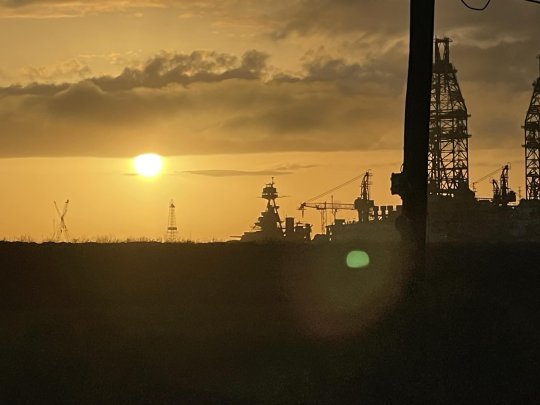
"DRY DOCK TOURS
Tours are now full through the entire month of January. We look forward to welcoming five hundred of you into the shipyard to see the amazing progress made to Battleship Texas!

A Dry Dock Tour participant approaches the bow of Battleship Texas.
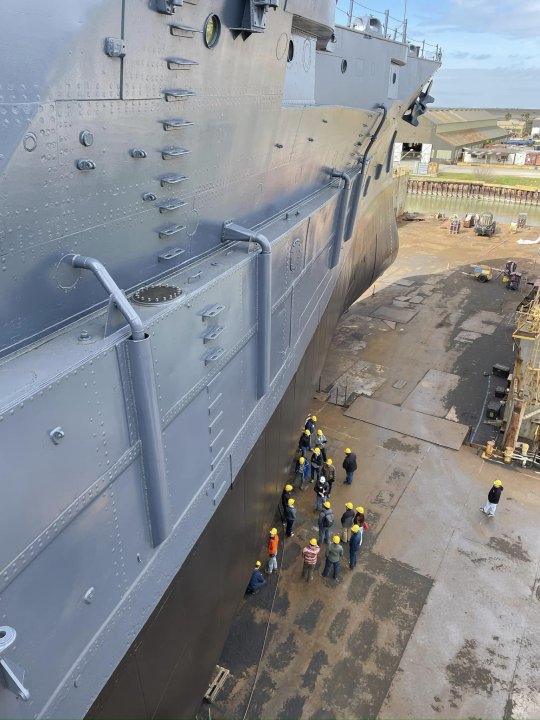
A dry Dock Tour wanders underneath Battleship Texas.
STEEL REPAIR - Steel repairs have been completed on the hull of Battleship Texas. The entire hull has been coated.

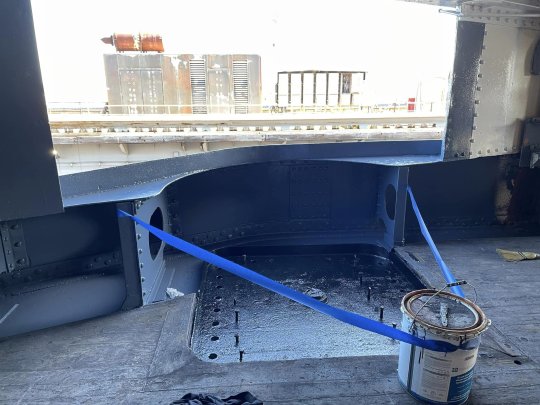
This area housed one of the 5”/51 cal. Guns. The deck has been blasted, coated, and awaits a layer of wood. The surrounding area and overhead has been blasted and painted white/navy blue 5-N. The guns are currently being restored and will be placed aboard next month.

Openings where the ships 5”/51 cal. Guns were. They are being restored and will be placed back next month.
HULL - The ship’s hull has been coated in PPG SIGMASHIELD 880 GF to protect the steel from potential corrosion. While the hull is supposed to be red below the black band at the waterline, the Battleship Texas Foundation has chosen to not spend the extra funds on a cosmetic choice that will not be seen once the ship is back in the water. The coatings that have been applied are plentiful and should protect the ship for many years to come.
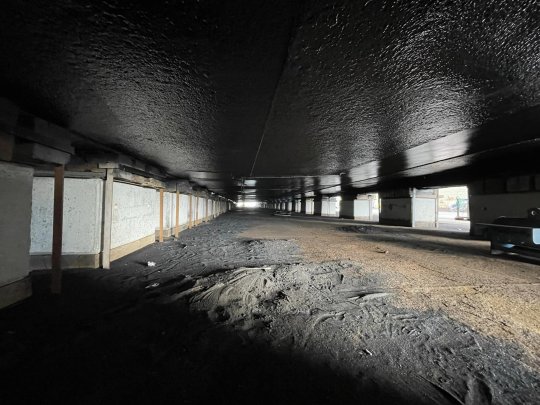
Looking under Battleship Texas.
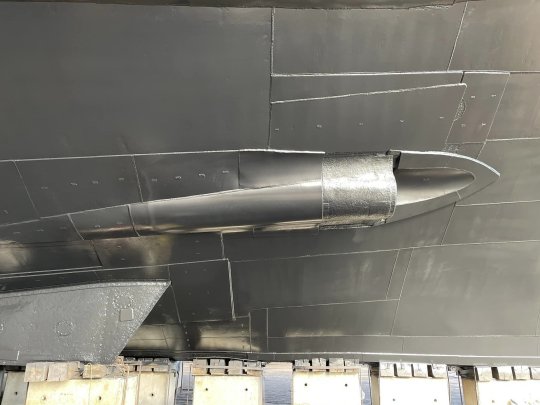
Steel repairs in this area are complete. The hull is now fully coated!
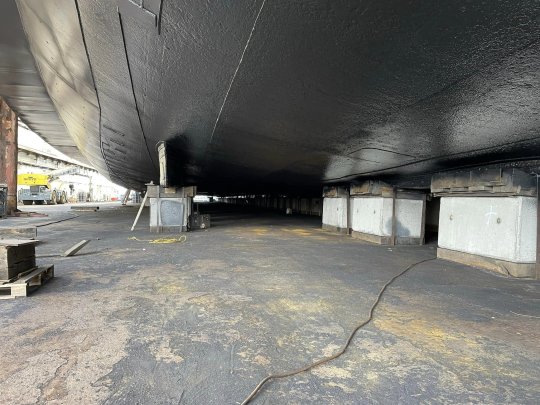
Underneath Battleship Texas.
NAVY BLUE 5-N - Above the boot top (above the black band) the ship has been painted Navy Blue 5-N. This color was matched from existing examples found aboard (both internally and externally) the vessel. The ship was painted in this camouflage scheme (Measure 21) prior to deploying to the Pacific Theater in World War II. At this time Battleship Texas is the ONLY museum ship painted in this scheme and only one of two Battleships in their wartime measure.
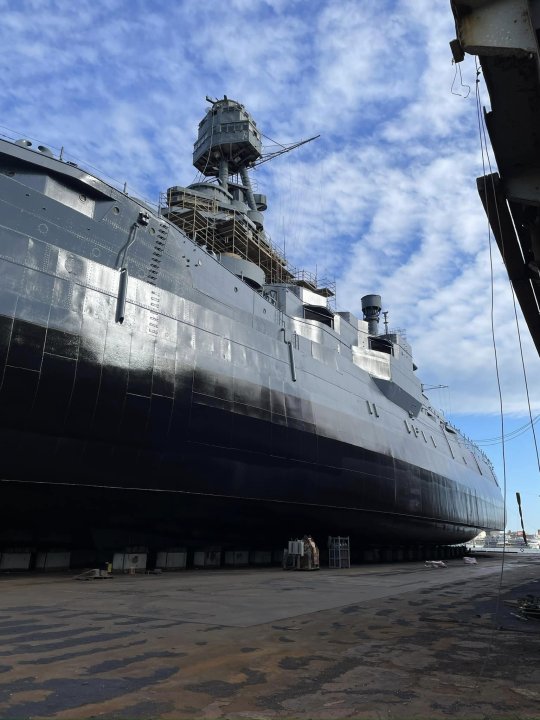
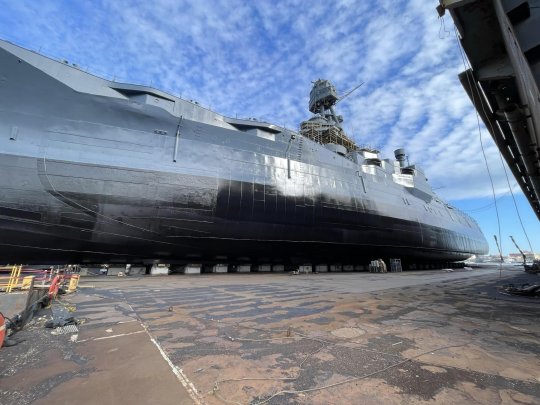
Torpedo Blisters: Complete Hull: Coated Navy Blue 5-N: Applied
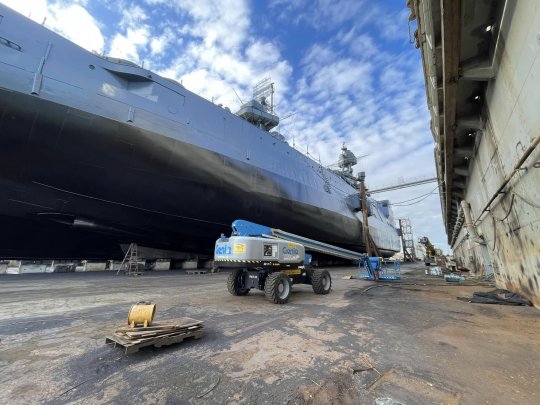
Starboard side of Battleship Texas.
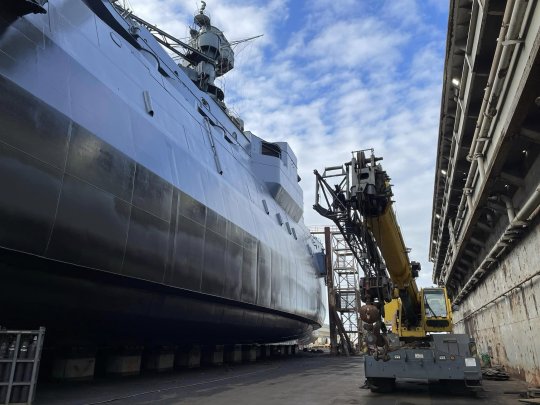
A crane sits beside Battleship Texas.
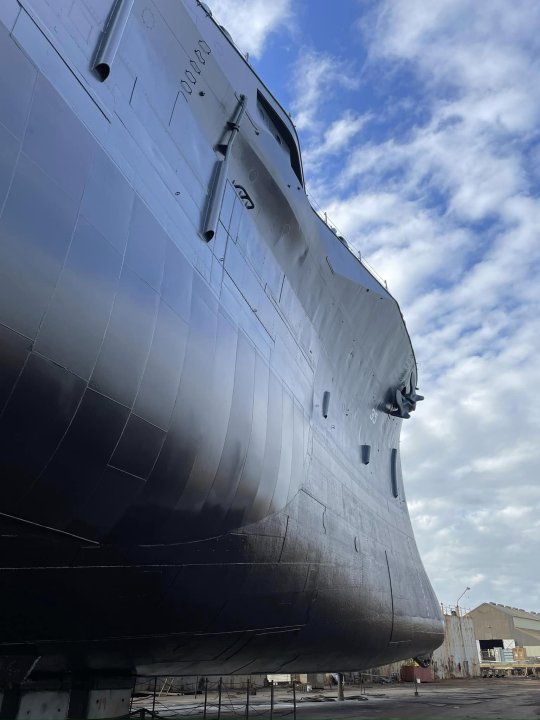
The bow of Battleship Texas.
HULL NUMBERS - The new hull numbers have been extensively researched so each number is not only the correct font, but applied in the appropriate position it was in 1945. The numbers have been applied to both bow and stern.
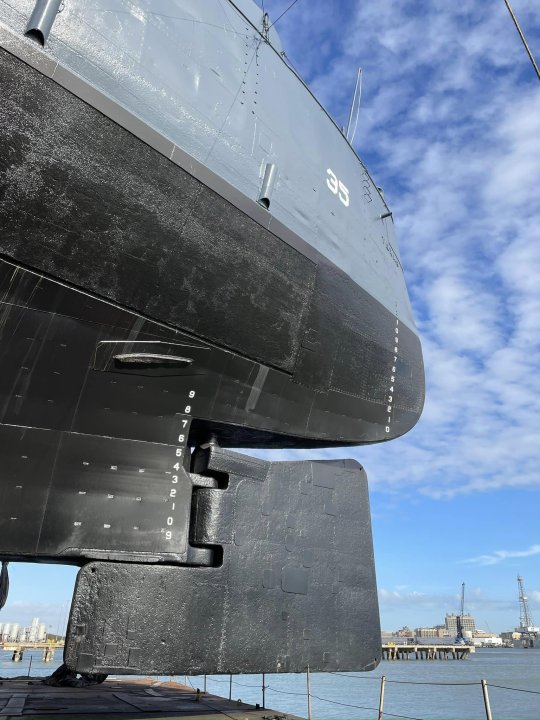
The ship’s name and hull number look great!
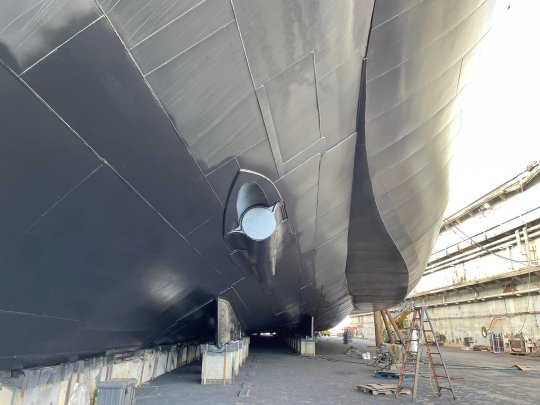
Steel repairs in this area are complete. The hull is now fully coated!
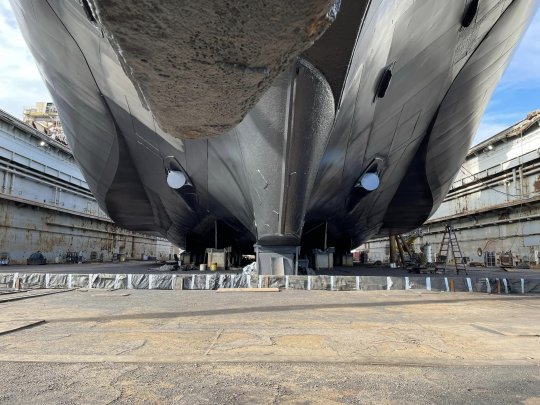
Sitting underneath the rudder and looking forward.
FREQUENTLY ASKED QUESTIONS:
KEEL BLOCKS - Yes, the keel blocks supporting Battleship Texas can be moved. Each block is moved so the area atop of them can be blasted, repaired (if need be), and coated.
SPLASH! - The ship will be put back into the water in February 2024, but is dependent on the weather.
WHAT’S NEXT? - Battleship Texas will remain at Gulf Copper Shipyard for the time being. Additional steel work, removal and replacement of the ship’s deck, and superstructure/aft fire control restoration will continue.
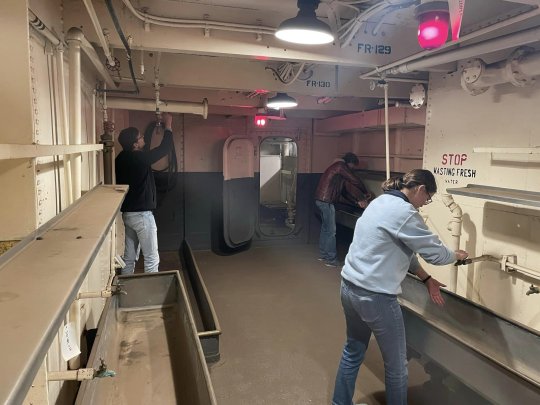
Dock hands venture into the ship’s crew wash room.

The ship’s cafeteria!

Take a look into Steering Gear!
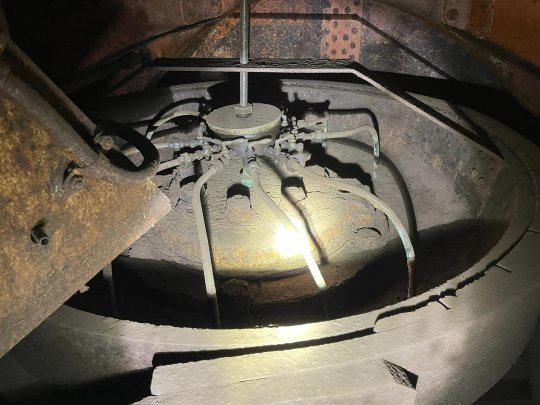
Take a look into Steering Gear!
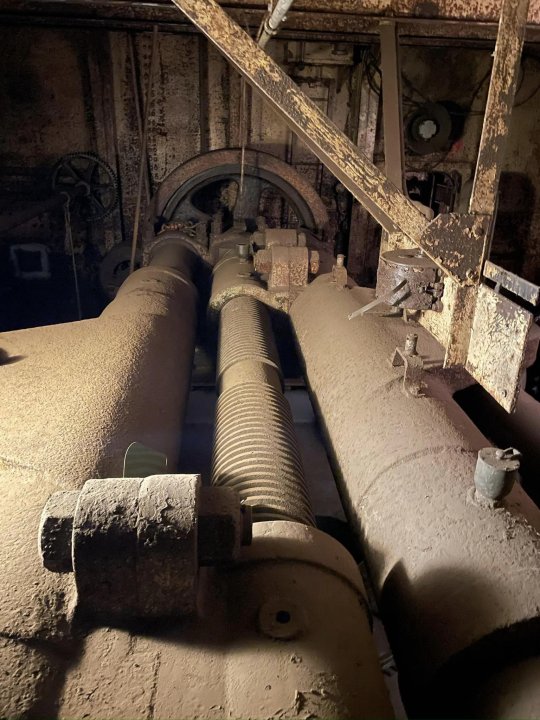
Take a look into Steering Gear!

Take a look into Steering Gear!

That’s not straight!
Live, Laugh, And Flood your Torpedo Blisters.
To donate to the preservation and operation of Battleship Texas, please visit: https://battleshiptexas.org/
Support Battleship Texas by making a purchase through the ship's store: https://store.battleshiptexas.org"
Posted on the Battleship Texas Foundation Facebook Group Page: link, link
#battleship Texas#Battleship Texas Foundation#Update#USS TEXAS (BB-35)#USS TEXAS#New York Class#Dreadnought#Battleship#Warship#Ship#Drydock#Dry Dock#Galveston#Texas#repairs#Gulf Copper#Restoration#January#2024#my post
88 notes
·
View notes
Note
I think you're one of my favorite Tumblr accounts even if it's a detector gimmick...
Have you visited the International Crane Foundation? And what's your favorite crane species?
wait I’m someone favorite?? AHHH TYSM!!!!
also I have not visited ICF, but it is on my bucket list!
My favorite crane species would probably be Demoiselle crane, not many people know about them but they’re gorgeous!

#I love all freshwater or swamp birds including ducks tho#I’m just biased towards cranes#not a crane#crane detectors incomprehensible babbling#birds
4 notes
·
View notes
Text
you heard it directly from the international crane foundation. the most ichabod can weigh is 22 pounds
4 notes
·
View notes
Text
Exploring Large Diameter Pipes – Construction Challenges and Solutions
Understanding Large Diameter Pipes
Large diameter (Dia) pipes are essential components in many infrastructure projects, including water supply systems, sewage treatment plants, and oil and gas pipelines. Their size and functionality enable the efficient transport of large volumes of liquids and gases, making them indispensable in modern construction. However, working with large diameter pipes presents unique challenges that require specialized solutions. Tube Trading, a leading large Dia pipe supplier in Vadodara, has extensive experience in addressing these challenges. This article explores the construction challenges associated with large diameter pipes and the solutions provided by industry leaders like Tube Trading, a prominent large Dia pipe dealer in Vadodara and a reliable large Dia pipe distributor in Gujarat.

Large diameter pipes are typically defined as pipes with a diameter of 24 inches (600 mm) or more. They are made from various materials, including steel, ductile iron, concrete, and plastic, each offering specific advantages depending on the application. These pipes are used in a variety of sectors, such as:
Water and Wastewater: For transporting potable water and sewage.
Oil and Gas: For transporting crude oil, natural gas, and refined products.
Industrial Applications: For transporting chemicals, slurry, and other industrial fluids.
Construction: As structural elements in large infrastructure projects.
Construction Challenges of Large Diameter Pipes
The installation and maintenance of large diameter pipes pose several challenges, which include:
1. Transportation and Handling
Transporting and handling large diameter pipes can be logistically complex due to their size and weight. These pipes often require special equipment and careful planning to ensure they are transported safely and efficiently.
Solution: Tube Trading, as a leading large Dia pipe distributor in Gujarat, uses specialized transportation methods and equipment to handle large diameter pipes. This includes flatbed trucks, cranes, and forklifts designed to accommodate the size and weight of these pipes. Their logistics team ensures that transportation complies with all safety regulations and standards.
2. Site Preparation and Trenching
Proper site preparation and trenching are critical for the successful installation of large diameter pipes. This involves clearing the site, excavating trenches, and ensuring that the ground conditions are suitable for pipe laying.
Solution: Tube Trading provides comprehensive site assessment and preparation services. They use advanced geotechnical surveys to analyze soil conditions and design appropriate trenching solutions. This minimizes the risk of ground instability and ensures a solid foundation for the pipes.
3. Jointing and Welding
Joining large diameter pipes securely is essential to prevent leaks and ensure the integrity of the pipeline. This can be particularly challenging with materials like steel, which require precise welding techniques.
Solution: As a top large Dia pipe dealer in Vadodara, Tube Trading offers expert welding and jointing services. Their team of certified welders uses state-of-the-art welding equipment and techniques to ensure strong, leak-proof joints. For non-metallic pipes, they provide specialized coupling systems that offer reliable connections.
4. Pressure Testing and Quality Assurance
Large diameter pipes used in critical applications, such as water supply and oil and gas transport, must undergo rigorous pressure testing to ensure they can withstand operational pressures without failing.
Solution: Tube Trading conducts thorough pressure testing and quality assurance checks on all pipes before installation. Their testing procedures comply with international standards, ensuring the pipes’ durability and reliability. This includes hydrostatic testing, where pipes are filled with water and pressurized to detect leaks and weaknesses.
5. Corrosion Protection
Corrosion can significantly reduce the lifespan of large diameter pipes, especially those made from metal. Protecting these pipes from corrosion is essential for long-term durability and performance.
Solution: Tube Trading offers a range of corrosion protection solutions, including coatings, linings, and cathodic protection systems. These measures protect the pipes from environmental factors and extend their service life. Their experts recommend the most suitable protection method based on the pipe material and operating conditions.
6. Environmental and Regulatory Compliance
Construction projects involving large diameter pipes must comply with environmental regulations and standards to minimize their impact on the environment.
Solution: Tube Trading is committed to environmentally responsible practices. They ensure all their projects comply with local and international environmental regulations. This includes using environmentally friendly materials and methods, as well as implementing measures to protect natural habitats and water sources during construction.
Innovative Solutions by Tube Trading
Tube Trading’s extensive experience and expertise in handling large diameter pipes make them a trusted partner for construction projects in Vadodara and Gujarat. Here are some innovative solutions they offer:
1. Custom Pipe Fabrication
Tube Trading provides custom fabrication services to meet specific project requirements. This includes custom lengths, bends, and fittings that ensure seamless integration with existing infrastructure. Their fabrication facilities are equipped with the latest technology to deliver high-precision products.
2. Comprehensive Project Management
From initial planning to final installation, Tube Trading offers comprehensive project management services. Their team of experts oversees every aspect of the project, ensuring timely completion and adherence to budget. This integrated approach minimizes disruptions and ensures smooth project execution.
3. Advanced Material Solutions
Tube Trading supplies a variety of pipe materials, including high-density polyethylene (HDPE), polyvinyl chloride (PVC), and ductile iron. Each material is chosen based on the specific needs of the project, offering optimal performance and cost-effectiveness. Their material experts provide guidance on selecting the best material for each application.
4. Technical Support and Training
Tube Trading provides technical support and training to ensure that construction teams are well-equipped to handle large diameter pipes. This includes training on installation techniques, safety procedures, and maintenance practices. Their support services ensure that clients have the knowledge and resources needed for successful project execution.
Why Tube Trading Stands Out
As a premier large Dia pipe supplier in Vadodara, Tube Trading has built a reputation for excellence and reliability. Their commitment to quality, innovation, and customer satisfaction sets them apart in the industry. Here’s why Tube Trading is the preferred choice for large diameter pipe solutions:
1. Extensive Industry Experience
With years of experience in the industry, Tube Trading has developed deep expertise in handling large diameter pipes. Their extensive portfolio of completed projects demonstrates their capability and reliability.
2. Quality Assurance
Tube Trading adheres to the highest quality standards in the industry. Their products undergo rigorous testing and inspection to ensure they meet or exceed client expectations. This commitment to quality ensures that clients receive durable, high-performance pipes for their projects.
3. Customer-Centric Approach
Tube Trading’s customer-centric approach ensures that clients receive personalized solutions tailored to their specific needs. Their team works closely with clients to understand their requirements and provide the most effective solutions.
4. Comprehensive Solutions
From supply and fabrication to installation and maintenance, Tube Trading offers end-to-end solutions for large diameter pipes. This comprehensive approach simplifies project management and ensures seamless execution.
Conclusion
Large diameter pipes are critical components in many infrastructure projects, but they come with unique construction challenges. Addressing these challenges requires specialized expertise and innovative solutions. Tube Trading, a leading large Dia pipe supplier in Vadodara, excels in providing comprehensive solutions that ensure successful project execution. Their commitment to quality, innovation, and customer satisfaction makes them a trusted partner for large diameter pipe projects in Vadodara and Gujarat. Whether you need custom fabrication, technical support, or comprehensive project management, Tube Trading is your go-to large Dia pipe dealer in Vadodara and a reliable large Dia pipe distributor in Gujarat.
#Large dia pipe distributor in Gujarat#Large dia pipe supplier in Vadodara#Large dia pipe dealer in Vadodara
4 notes
·
View notes
Text
Top Hydraulic Cylinder Manufacturer in India
Top Hydraulic Cylinder Manufacturers in India: A Glimpse into the Industry
Hydraulic cylinders are integral components used in a wide range of industrial applications. They provide mechanical force and motion through hydraulic pressure, playing a key role in various sectors such as construction, agriculture, mining, and material handling. As industries evolve and expand, the demand for high-performance hydraulic cylinders grows. India, with its vast industrial landscape, is home to numerous hydraulic cylinder manufacturers, each contributing significantly to the sector.
This article delves into the essential characteristics and qualities that define the top hydraulic cylinder manufacturers in India, highlighting what makes them stand out in this competitive field.

1. Expertise in Design and Engineering
The foundation of any high-quality hydraulic cylinder lies in the design and engineering process. Hydraulic cylinders are subjected to extreme pressure, and thus their design must ensure durability, reliability, and performance. Top hydraulic cylinder manufacturers in India invest heavily in research and development (R&D) to stay at the forefront of technological advancements.
They utilize cutting-edge tools like Computer-Aided Design (CAD) and Finite Element Analysis (FEA) to create precise and efficient designs. These technologies help in predicting how the cylinder will perform under various stress conditions, ensuring long-lasting performance.
A strong focus on engineering excellence is crucial for developing hydraulic cylinders that meet the needs of a wide range of industries, whether it's for lifting heavy loads, precision machinery operation, or tough construction tasks.
2. High-Quality Manufacturing Standards
The best hydraulic cylinder manufacturers in India adhere to strict quality control standards. This includes using top-grade materials such as high-strength carbon steel, alloy steels, and stainless steel to ensure the durability and strength of the cylinders. They are also committed to continuous improvement in their manufacturing processes to enhance product performance.
Leading manufacturers undergo rigorous testing, including pressure, fatigue, and dimensional checks, to ensure that their products meet both domestic and international quality standards. Compliance with ISO certifications and other industry standards is common among top manufacturers, providing customers with the assurance that they are receiving high-quality products.
3. Customization for Specific Needs
Different industries have varying requirements for hydraulic cylinders. For example, the construction sector might need cylinders with high lifting capacities, while the automotive or agricultural industries might require smaller, more compact solutions. The top hydraulic cylinder manufacturers in India offer tailored solutions that are designed to meet the specific needs of each application.
Whether it's a custom size, specific stroke length, or unique mounting configuration, the best manufacturers have the expertise to create hydraulic cylinders that fit the exact requirements of their clients. This ability to customize makes them an ideal partner for industries that need specialized solutions.
4. Wide Product Range
The versatility of hydraulic cylinders is showcased through the wide variety of models that manufacturers offer. The best manufacturers in India provide a range of hydraulic cylinders to suit different applications, such as:
Single-Acting Cylinders: Used when force is needed in one direction, such as in lifts or presses.
Double-Acting Cylinders: Designed to provide force in both directions, commonly used in more dynamic applications.
Telescopic Cylinders: These are ideal for applications that require a long stroke but need to fit in compact spaces, such as in dump trucks and mobile cranes.
Rotary Actuators: Some manufacturers also offer hydraulic rotary actuators that provide rotational movement in addition to linear motion.
By offering a diverse product portfolio, top manufacturers can serve multiple sectors, from heavy machinery to precision equipment.
5. Commitment to After-Sales Service
Top hydraulic cylinder manufacturers in India understand the importance of providing excellent after-sales support. Since hydraulic cylinders are integral to the functioning of machinery, it is essential that they are well-maintained and serviced regularly. A strong after-sales service network ensures that customers can get the support they need when issues arise.
Services typically include installation assistance, routine maintenance, repairs, and the provision of replacement parts. By offering comprehensive after-sales service, manufacturers not only enhance customer satisfaction but also ensure the long-term performance of their products.
6. Efficient Delivery and Supply Chain Management
In today’s competitive industrial landscape, timely delivery is key. Delays in receiving hydraulic cylinders can lead to project halts or machine downtimes, causing financial losses for businesses. The best manufacturers in India have established efficient supply chain and logistics networks that ensure their products are delivered on time, no matter the location.
These manufacturers maintain well-managed inventories and often offer direct shipping to clients, ensuring that businesses can keep their operations running smoothly without delays. Their focus on reducing lead times and ensuring reliability makes them a preferred choice for customers across industries.
7. Affordability Without Compromising Quality
While high-quality products are important, cost-effectiveness is equally crucial. Hydraulic cylinders are often a significant investment for businesses, and manufacturers that can provide cost-effective solutions without compromising on quality have a competitive edge.
Leading manufacturers in India focus on optimizing their production processes, reducing waste, and leveraging economies of scale to offer high-quality products at competitive prices. This allows businesses to make the most of their investments while still enjoying the durability and reliability that come with superior hydraulic cylinders.
8. Sustainability Practices
As industries and consumers become more environmentally conscious, sustainable practices have become a key consideration for hydraulic cylinder manufacturers in India. The best manufacturers are increasingly adopting eco-friendly practices, such as reducing energy consumption during production and using recyclable materials.
By focusing on sustainability, these manufacturers not only help protect the environment but also position themselves as leaders in a market that values eco-conscious business practices. This shift towards sustainability is a key differentiator for many of India’s top hydraulic cylinder manufacturers.
Conclusion
India is home to a thriving hydraulic cylinder manufacturing industry, with numerous companies providing high-quality, customized solutions to meet the demands of diverse industrial applications. The best hydraulic cylinder manufacturers in India distinguish themselves through their expertise in design, manufacturing excellence, and commitment to customer satisfaction.
From offering innovative, custom solutions to ensuring timely deliveries and high-quality after-sales support, these manufacturers play a pivotal role in driving the success of industries that rely on hydraulic systems. As the demand for advanced hydraulic technology continues to grow, India’s top manufacturers are poised to remain at the forefront of the global market.URL: For more information, visit Verdant Pharma : Top Hydraulic Cylinder Manufacturer in India
0 notes
Text
Maximize Construction Flexibility with YHZS50 Mobile Concrete Mixing Plant Equipment
The YHZS50 mobile concrete mixing plant stands out as a game-changer for construction projects requiring rapid deployment and high-efficiency output. Designed for portability, this equipment integrates material storage, weighing, mixing, and control systems into a compact unit, enabling quick relocation and minimal foundation requirements—ideal for highways, bridges, and remote sites.ts modular structure allows disassembly within a day using a 30-ton crane, ensuring seamless transitions between job sites without compromising productivity.

Mobile concrete mixing plant equipment like the YHZS50 model features advanced automation, including precision sensors and imported reducers, to guarantee consistent mixing quality and reduce operational downtime.With a production capacity of 50 m³/h, it supports diverse concrete types—from dry-hard to plastic mixes—ensuring versatility for infrastructure and commercial projects.The inclusion of real-time monitoring systems further enhances operational transparency, allowing for data-driven decision-making. For contractors seeking mobile concrete mixing plant for sale, reputable manufacturers such as SISOUL and Henan Better Heavy Industry offer CE-certified models with global compliance, ensuring durability and ease of maintenance.These plants are backed by modular designs, energy-efficient performance, and scalable configurations, making them a cost-effective investment for both domestic and international markets. By prioritizing mobility, precision, and adaptability, the YHZS50 and similar equipment empower construction teams to meet tight deadlines while maintaining high standards. Explore reliable suppliers today to elevate your project efficiency and competitiveness.
#Mobile concrete mixing plant#Mobile concrete mixing plant equipment#mobile concrete mixing plant for sale
0 notes
Text
Jib Crane for Sale: A Comprehensive Guide to Choosing the Right Solution
When it comes to lifting and moving heavy loads efficiently, jib cranes are an indispensable asset in various industries. Whether in manufacturing, construction, or warehouses, these cranes enhance productivity and safety. If you're searching for a jib crane for sale, understanding the types, benefits, and how to choose a reliable jib crane supplier is crucial.
This guide explores everything you need to know before making an investment in a jib crane hoist and how to find the right supplier for your needs.

What is a Jib Crane?
A jib crane inspection is a type of lifting equipment designed for material handling within a specific work area. Unlike overhead cranes, they are compact and ideal for localized lifting.
Types of Jib Cranes
Type
Description
Ideal For
Freestanding Jib Crane
Mounted on a concrete foundation, providing full 360-degree rotation.
Heavy-duty lifting, warehouses, outdoor work.
Wall-Mounted Jib Crane
Fixed to a structural wall or column, offering 180-degree rotation.
Workstations, assembly lines, factories with space limitations.
Mast-Type Jib Crane
Requires both floor and overhead support but offers high load capacity.
High-ceiling facilities, manufacturing plants.
Articulating Jib Crane
Features two swiveling arms for increased flexibility.
Precision lifting, confined spaces, maneuvering around obstacles.
Key Benefits of Using a Jib Crane Hoist
Enhanced Productivity: Reduces manual labor and speeds up material handling processes.
Space Optimization: Unlike gantry or bridge cranes, jib cranes occupy minimal space.
Safety & Ergonomics: Minimizes workplace injuries caused by manual lifting.
Customizable Options: Can be tailored to specific industrial requirements.
Cost-Effective Solution: Lower operational costs compared to larger crane systems.
Testimonial: What Industry Experts Say
"We installed a freestanding jib crane hoist in our warehouse, and it significantly improved our workflow. The lifting process is smoother, and worker fatigue has reduced dramatically." — Michael T., Warehouse Operations Manager
How to Choose the Best Jib Crane Supplier
Selecting the right jib crane supplier ensures you get a durable and high-performing product. Here are key factors to consider:
1. Industry Experience & Reputation
Look for suppliers with a proven track record and industry expertise. Established suppliers provide better quality control and after-sales support.
2. Customization & Product Range
A reliable jib crane supplier should offer various crane types and customization options to meet specific needs.
3. Quality & Compliance Standards
Ensure the crane meets international safety standards, such as: ✅ OSHA (Occupational Safety and Health Administration) ✅ ANSI (American National Standards Institute) ✅ ISO Certifications
4. Installation & After-Sales Support
A reputable supplier should provide professional installation, maintenance, and support services.
5. Pricing & Warranty
Compare prices, but don’t compromise on quality. Check warranty terms to safeguard your investment.
Testimonial: Customer Experience Matters
"We partnered with a top jib crane supplier who offered customization for our facility. Their support team was responsive, and the installation process was seamless!" — Sarah L., Manufacturing Plant Supervisor
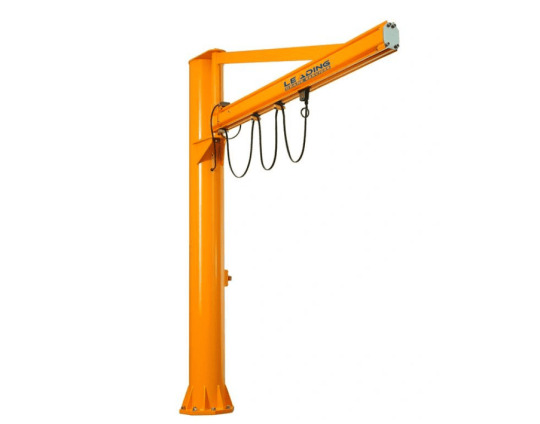
Final Thoughts: Making the Right Investment
Investing in a jib crane hoist is a game-changer for industries looking to enhance operational efficiency. Whether you need a freestanding, wall-mounted, or articulating model, choosing a reliable jib crane supplier is key to ensuring long-term performance and safety.
Before purchasing a gantry crane for sale, assess your lifting needs, workspace constraints, and supplier credibility. A well-informed decision will maximize productivity and operational success.
0 notes
Text
Trends in Bridge Construction

The bridge construction industry is experiencing a remarkable transformation, driven by technological advancements, sustainable practices, and the growing demands of modern transportation infrastructure. Across continents, engineers and construction experts are pushing the boundaries of what's possible in bridge design and implementation.
In North America, massive projects are redefining infrastructure capabilities. The Gordie Howe International Bridge, spanning the Detroit River between the United States and Canada, represents a pinnacle of modern bridge engineering. With a staggering budget of US$4.8 billion, this groundbreaking project features the longest main span of any cable-stayed bridge in North America, stretching 853 meters. What makes this bridge truly remarkable is its innovative design. It uses no in-water piers for support and incorporates a multi-use path for pedestrians and cyclists, along with advanced security and travel time detection systems.
Across the Pacific, China is making equally impressive strides. The Shiziyang Bridge in Guangzhou will become the world's largest double-deck suspension bridge, with a mind-boggling total length of 35 kilometers. The project showcases cutting-edge construction technology, with manufacturers like Sany and Zoomlion deploying state-of-the-art equipment. Concrete pours involving 25,000 cubic meters and tower cranes with lifting capacities of 20,000 tonnes demonstrate the sheer scale of modern bridge construction.
Sustainability has become a critical focus in bridge development. Engineers are increasingly embracing eco-friendly materials and construction methods that minimize environmental impact. Recycled steel, composite materials, and environmentally friendly concrete mixes are becoming standard. Prefabrication and modular construction techniques are revolutionizing bridge construction, allowing for faster construction times, improved quality control, and reduced carbon footprints.
Smart technology is another game-changing trend. Modern bridges are no longer static structures but intelligent systems with sensors and IoT devices. These technologies enable real-time monitoring of structural health, traffic flow, and potential maintenance needs. By integrating data analytics, engineers can predict and prevent potential issues before they become critical, enhancing safety and efficiency.
The industry is also responding to the challenges of climate change and extreme weather events. Resilient infrastructure has become a key priority, with engineers developing bridges capable of withstanding hurricanes, floods, and earthquakes. This involves utilizing robust materials, creating innovative foundation designs, and building redundancy into structural systems.
Transportation evolution is also driving bridge innovation. High-speed rail networks and expanding transportation hubs require bridges supporting significant weights and high-speed trains. In the United Kingdom, projects like the HS2 rail expansion demonstrate innovative approaches to bridge construction, including advanced transportation techniques such as massive bridge relocation using modular transporters.
Rehabilitation and maintenance of existing infrastructure are equally important. With many bridges aging, there's an increasing demand for advanced inspection and repair technologies. Drones, robotic systems, and sophisticated monitoring techniques are being employed to assess and extend the lifespan of existing structures without disrupting traffic.
From the intricate modular bridge in Birmingham, England, to the massive suspension bridges of China, the global bridge construction market is experiencing a renaissance. As urban populations grow and transportation needs become more complex, bridge construction will continue to evolve. The bridges of tomorrow will be more than just functional structures; they will be intelligent, sustainable, and resilient monuments to human creativity and technological progress.
0 notes
Text
How Can Beginners Start Learning Real Kung Fu?
Real Kung Fu is more than just a martial art, it is a culture rooted in centuries of tradition. For beginners, starting to learn real Kung Fu can be daunting because it is complex and profound. However, by focusing on key foundational techniques and understanding the essence of this art, learners can gradually build their skills and confidence. The following is a detailed guide on how beginners can start learning real Kung Fu and which basic techniques should be mastered first.
Step 1: Understand the Philosophy of Real Kung Fu
Kung Fu is more than physical combat; it embodies philosophical principles like balance, patience, respect, and perseverance. Before diving into physical training, it’s important to learn the core values that guide practitioners:
Discipline: Consistent practice is essential for improvement.
Mind-Body Connection: Real Kung Fu emphasizes harmony between the mind and body, which improves focus and reaction time.
Respect: Respect for instructors, fellow students, and even opponents is a fundamental part of training.
Step 2: Choose the Right Kung Fu Style
Kung Fu offers a broad spectrum of styles, each with its own distinct philosophy, techniques, and training methods, catering to different skill sets and personal goals:
1. Shaolin Kung Fu: Renowned for its rigorous training and explosive power, Shaolin Kung Fu emphasizes both physical strength and mental discipline. It features dynamic movements, high jumps, and precise strikes, making it an ideal style for developing overall fitness and martial prowess.
2. Wing Chun: Wing Chun is a close-combat style known for its efficiency, economy of movement, and focus on straight-line attacks. Designed to use an opponent’s force against them, this style is perfect for self-defense and reflex training.
3. Tai Chi: Tai Chi is a soft, internal style focusing on slow, deliberate movements that enhance balance, flexibility, and internal energy (Qi). Though gentle in appearance, Tai Chi offers effective martial applications and is widely practiced for its health benefits.
4. Animal Fist: This style mimics the movements and spirit of various animals, such as the tiger, crane, snake, and monkey. Each animal form emphasizes different combat strategies—strength, agility, or precision��providing practitioners with a versatile skill set.
5. Soft Qigong: Soft Qigong focuses on cultivating internal energy through gentle, flowing movements combined with deep breathing techniques. This style promotes relaxation, improves flexibility, and enhances overall health, making it suitable for all age groups.
6. Hard Qigong: Unlike Soft Qigong, Hard Qigong trains the body to withstand extreme physical stress and develop exceptional strength. Practitioners often demonstrate their skills by breaking bricks or withstanding strikes, showcasing the high level of toughness achievable.
7. Sanda & Qin Na: Sanda, also known as Chinese kickboxing, focuses on practical combat techniques, combining punches, kicks, and throws. Qin Na involves joint locks and grappling techniques used to control or immobilize opponents, making it an essential skill for real-world self-defense.
8. Ba Ji Quan: Ba Ji Quan is famous for its explosive power and close-range fighting techniques. It emphasizes strong elbow strikes, body checks, and low stances. Known for its effectiveness, Ba Ji Quan was historically used by bodyguards of Chinese emperors.
Step 3: Master Basic Stances
Stances form the foundation of all Kung Fu movements. A strong stance provides balance, stability, and power. Key stances to learn include:
Horse Stance (Mǎ Bù): A low, wide stance that builds leg strength and stability.
a.Feet are parallel and shoulder-width apart.
b.Knees are bent deeply, and the back remains straight.
Bow Stance (Gōng Bù): Used for transitioning between strikes and blocks.
a.One leg is bent forward, while the rear leg remains straight.
Cat Stance (Xū Bù): A light, agile stance useful for quick movements.
The weight is mostly on the back leg, with the front foot lightly touching the ground.
Practicing these stances daily will improve strength, endurance, and balance.
Step 4: Learn Basic Strikes and Blocks
Kung Fu strikes are precise and powerful, designed to disable an opponent quickly. Beginners should focus on the following techniques:
Straight Punch (Zhí Quán): A direct punch aimed at the opponent’s centerline.
Palm Strike (Zhǎng Tǐng): A versatile strike that uses the base of the palm to hit sensitive areas.
Low Block (Dǐ Gé): A defensive move to block kicks or low attacks.
High Block (Shàng Gé): Used to defend against strikes to the head or upper body.
Start by practicing these strikes and blocks slowly, focusing on proper form before increasing speed and power.
Step 5: Focus on Footwork
Footwork is crucial in real Kung Fu for maintaining balance, positioning, and evading attacks. Beginners should practice moving smoothly and efficiently in all directions. Drills to improve footwork include:
Step-and-Punch Drill: Step forward with one foot while delivering a punch, then step back into a defensive stance.
Sidestep Drill: Practice moving sideways to evade imaginary attacks while keeping your stance intact.
Good footwork allows practitioners to stay mobile, creating opportunities for counterattacks and defense.
Step 6: Build Flexibility and Strength
Real Kung Fu demands flexibility and strength to execute techniques effectively. Beginners should incorporate stretching exercises to improve flexibility, especially in the hips, legs, and shoulders. Strength training should focus on bodyweight exercises such as:
Squats: To strengthen the legs for stances.
Push-ups: To develop upper body strength for strikes.
Planks: To build core stability.
Improved flexibility and strength will enhance overall performance and reduce the risk of injury.
Step 7: Practice Breathing and Meditation
Breathing techniques are a vital part of real Kung Fu, helping practitioners stay calm and focused. Controlled breathing also enhances endurance during training. A common practice is Diaphragmatic Breathing, where one breathes deeply into the abdomen rather than the chest.
Additionally, meditation is often practiced to develop mental clarity and internal energy (Qi). Beginners can start with 5-10 minutes of quiet meditation daily to center their thoughts and improve concentration.
Step 8: Join a Kung Fu School or Find a Mentor
While self-training is possible, having an experienced instructor or mentor can greatly accelerate learning. A good instructor can correct mistakes, provide personalized guidance, and introduce advanced techniques when ready.
When selecting a school or instructor:
Look for those with verifiable credentials in real Kung Fu.
Visit the school to observe classes and teaching methods.
Choose a school that emphasizes both the physical and philosophical aspects of Kung Fu.
Xinglin Traditional Shaolin Kung Fu Academy is an authentic Chinese martial arts academy where you can learn real Kung Fu under the guidance of Shaolin monks.
Step 9: Set Realistic Goals
Progress in Kung Fu takes time and dedication. Beginners should set achievable short-term and long-term goals. Examples include:
Mastering basic stances and strikes within the first month.
Increasing flexibility by practicing daily stretches.
Learning a simple form or sequence by the end of the first three months.
By setting realistic goals, learners can stay motivated and track their progress.
Conclusion
Beginning to learn real kung fu is both exciting and challenging. By understanding the philosophy, choosing the right style, mastering basic postures and techniques, and incorporating strength, flexibility, and breathing exercises, beginners can build a solid foundation for long-term success. With consistent practice, patience, and guidance, real kung fu can become not only a powerful martial art, but also a lifelong discipline for physical and personal development.
So, fasten your belt, find your posture, and take the first step toward mastering real kung fu!
0 notes
Text
How were pyramids built step by step: Secrets of the Pharaohs
The pyramids of Egypt, especially the Great Pyramid of Giza, are among the most fascinating architectural achievements in human history. Despite many theories, the exact method of construction remains a mystery. However, based on archaeological evidence, expert studies, and historical records, how were pyramids built step by step? process for how these massive structures were built.
Step 1: Selecting the Site
The ancient Egyptians chose specific locations for their pyramids. Most were built on the west bank of the Nile, where the sun sets, symbolizing the journey to the afterlife. The site needed to be near the river for easy transportation of materials and on stable ground to support the enormous weight of the pyramid.
Step 2: Preparing the Foundation
Once the site was selected, workers leveled the ground. This was crucial to ensure the pyramid remained stable over time. They used tools like copper chisels and stone hammers to remove excess rock and sand, creating a solid and level base.
Step 3: Quarrying and Transporting Stones
The limestone blocks used for construction were quarried nearby. Workers used copper tools to cut and shape the stones. The massive granite blocks used in the inner chambers were transported from Aswan, over 800 km away.
How Were the Stones Moved?
Workers dragged the stones on sleds.
Wetting the sand in front of the sleds reduced friction, making transportation easier.
Large wooden rollers and levers may have also been used.
Boats transported stones along the Nile to the construction site.
Step 4: Building the Pyramid Using Ramps
Since cranes and modern machinery did not exist, ancient Egyptians likely used a ramp system to move stones up the pyramid. There are several theories:
Straight Ramp: A long, straight ramp extended from the ground to the upper levels.
Zigzagging Ramp: A ramp wrapped around the pyramid in a spiral.
Internal Ramps: Hidden ramps inside the structure may have helped move stones upward.
Step 5: Placing the Stones with Precision
Workers arranged the limestone blocks carefully, aligning them with the cardinal directions (north, south, east, and west). Each layer was built up systematically, with the blocks fitting tightly together.
To ensure precision:
The Egyptians used tools like plumb bobs and leveling instruments.
They may have measured angles using the stars.
Skilled workers carved and polished the stones to fit seamlessly.
Step 6: Finishing the Pyramid
Once the main structure was completed:
The pyramid was covered with smooth white limestone casing stones to create a shining effect.
The peak, or capstone (pyramidion), was placed on top, possibly covered in gold to reflect sunlight.
Internal chambers and passageways were decorated with inscriptions and hieroglyphs.
Step 7: Constructing Additional Structures
The pyramids were part of a larger complex, including:
Mortuary Temples: For rituals and offerings.
Causeways: Paths leading to the pyramid.
Smaller Pyramids: For queens and important officials.
Conclusion
The construction of the pyramids was a remarkable achievement, requiring advanced knowledge of engineering, mathematics, and labor organization. While the exact methods remain uncertain, the step-by-step process highlights the ingenuity and determination of the ancient Egyptians.
0 notes